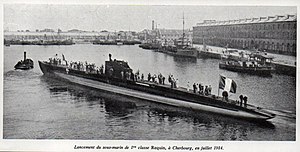French submarine Requin (1924)
The French submarine Requin was the lead ship of the Requin-class submarines built for the French Navy in the mid-1920s. Laid down in June 1922, it was launched in July 1924 and commissioned in May 1926. It was captured by Italian forces at Bizerte, Tunisia on 8 December 1942 and renamed FR 113. On 9 September 1943, it was recaptured by German forces. It was sold for scrap in Genes, Italy in 1944.[1][2]
 Requin in 1924 | |
| History | |
|---|---|
| Name: | Requin |
| Builder: | Arsenal de Cherbourg |
| Laid down: | 14 June 1922 |
| Launched: | 19 July 1924 |
| Commissioned: | 28 May 1926 |
| Fate: | Scrapped in 1944 |
| General characteristics | |
| Class and type: | Requin-class submarine |
| Displacement: | |
| Length: | 78.30 m (256 ft 11 in) |
| Beam: | 6.84 m (22 ft 5 in) |
| Draught: | 5.10 m (16 ft 9 in) |
| Propulsion: |
|
| Speed: |
|
| Range: |
|
| Test depth: | 80 m (260 ft) |
| Complement: | 51 men |
| Armament: |
|
Design
78 m (255 ft 11 in) long, with a beam of 6.8 m (22 ft 4 in) and a draught of 5.1 m (16 ft 9 in), Requin-class submarines could dive up to 80 m (260 ft). The submarine had a surfaced displacement of 1,150 tonnes (1,132 long tons) and a submerged displacement of 1,441 tonnes (1,418 long tons). Propulsion while surfaced was provided by two 2,900 hp (2,163 kW) diesel motors and two 1,800 hp (1,342 kW) electric motors. The submarines' electrical propulsion allowed it to attain speeds of 9 knots (17 km/h; 10 mph) while submerged and 15 knots (28 km/h; 17 mph) on the surface. Their surfaced range was 7,700 nautical miles (14,300 km) at 9 knots (17 km/h), and 4,000 nautical miles (7,400 km) at 12 knots (22 km/h), with a submerged range of 70 nautical miles (130 km) at 5 knots (9.3 km/h).[4]
References
- "FR Requin of the French Navy - French submarine of the Requin class - Allied Warships of WWII". uboat.net. Retrieved 22 October 2018.
- "Batiments ayant porté le nom de Requin". www.netmarine.net.
- "Requin Class French Submarines". battleships-cruisers.co. Retrieved 22 October 2018.